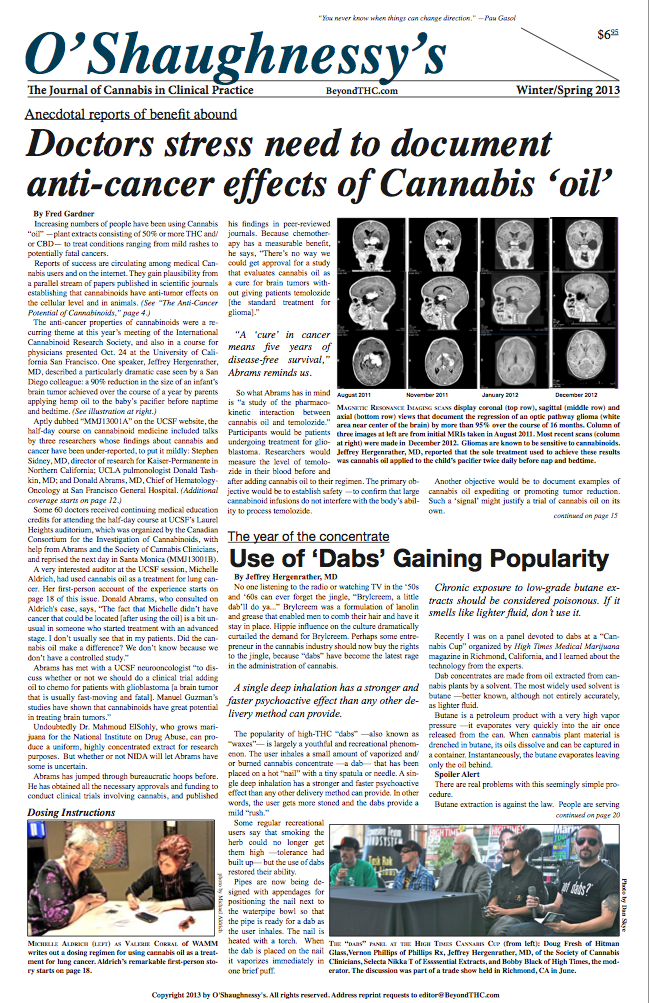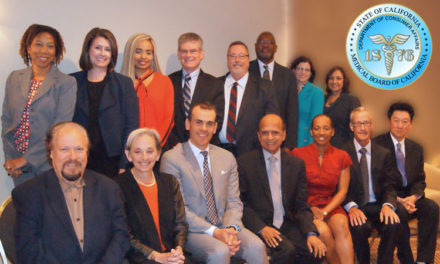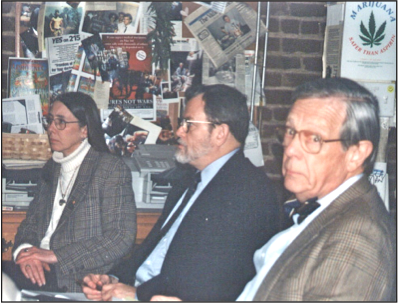Glantzing Blows
Stanton Glantz, PhD, the UCSF professor who has led the crusade against cigarette smoking, is making headlines again as co-author of a paper proposing that “a comprehensive public health education and regulatory framework modeled on the California Tobacco Control Program, to minimize social normalization and use, be established concurrently with full legalization, before a marijuana industry similar to the tobacco industry fully develops in California.”
Glantz and co-author Robin Barry, MA, start from the premise that marijuana and tobacco are equally harmful, and therefore their conclusion is quite logical. (See the executive summary below.)
I worked at UCSF for 13 years and was introduced to Glantz four or five times, and each time I had the impression he didn’t remember me. He lived in the Sunset District and so did I, and we both rode bikes to work. One morning in 1997, when Monica Lewinsky had just become a household word, I saw Glantz biking along Irving St. and pedaled alongside him (without a helmet, which probably didn’t create a good impression). I said, “Stan, this situation Bill Clinton is in —it’s all your fault.” He was very puzzled, of course, and asked what I meant. I told him my wife’s theory: “Hillary made such a big deal about not letting him smoke in the White House. Wouldn’t let him smoke his cigars.” Glantz nodded. I continued, “So he came on to the intern by rubbing a cigar on her pussy. You don’t have to be Sigmund Freud to figure out that he was expressing his resentment.”
The psychological plausibility registered and Glantz recoiled slightly like he’d been hit by a jab on the chin. Or maybe it was just the uncouth language coming from a “staff person” to a professor, as if we were social equals.
Flash forward to 2011. Dr. Jeffreey Hergenrather and I were looking for help putting the SCC and Project CBD websites online. A young man with the great name of Michael LaTulippe had been recommended, and we arranged to meet him at a cafe in the Outer Sunset for brunch on a Sunday morning. At one point Stan Glantz and his wife came and sat down at a table. I had some O’Shaughnessy’s and brought two copies over to their table. I introduced myself to Stan for the fifth or sixth time, and told him that after I left UC I’d done a stint at the District Attorney’s office and now I was putting out a journal of sorts covering the medical marijuana story. He had to take the paper but he didn’t look happy about it. And his wife actually shook her head lest I hand her one.
I told them that Donald Tashkin (a real doctor) had found that smoking cannabis does not cause lung cancer, but they were shaking their heads as if to say, “Our minds are made up, don’t confuse us with facts.”
Donald Abrams, MD, tells a similar story about an encounter with Dianne Feinstein, who quickly cut him off with “We’ll have to agree to disagree.”
Here’s the gist of the paper by Glantz and Barry:
Executive Summary
• Even though tobacco is legal in California, its use is not socially accepted and prevalence is falling.
• Marijuana is illegal, but its use is socially accepted and its prevalence is increasing.
• The fact that most marijuana sales and possession is illegal has led to serious negative social costs, particularly imprisonment of hundreds of thousands of nonviolent offenders, mostly young black men, and existence of an illegal market that generates crime, violence, and corruption.
• This report is based on the premise that treating marijuana like tobacco – legal but unwanted – under a public health framework is an appropriate response to the social inequities and large public costs of the failed War on Drugs.
• The two major legalization initiatives (Adult Use of Marijuana Act and Marijuana Legalization Initiative Statute) do not accomplish this goal.
• The initiatives are written primarily to create a new business and only include minimal protections for the public that are unlikely to prevent public health harms caused by the burgeoning marijuana industry.
• The tobacco industry has been considering entering the marijuana business since 1969.
• There is evidence that marijuana use and secondhand exposure pose health risks, including increased risk for cancer, heart attack, stroke, reproductive toxicity, respiratory impairment, long-lasting detrimental changes in brain function, and increased risk for addiction.
• As marijuana use increases it is likely that the understanding of these disease links willbecome more detailed and extensive.
• Evidence from tobacco and alcohol control demonstrates that without a strong public health
framework, a wealthy and politically powerful marijuana industry will develop and use its political clout to manipulate regulatory frameworks and thwart public health efforts to reduce use and profits.
• Successes and failures regulating tobacco products, alcoholic beverages, public utilities, and other products in California, as well as the lessons from other state regulatory efforts, should be applied to marijuana regulations if California legalizes the cultivation, production, marketing, and retail sale of marijuana.
• The goal of any marijuana regulatory framework should be to treat marijuana regulation like tobacco regulation, allowing sale and use to be legal, while simultaneously creating an environment where falling numbers of people are interested in buying and using it.
• To minimize public health risks, marijuana regulations in California should be modeled on the California Tobacco Control Program, which has successfully countered the lobbying and marketing tactics of the tobacco industry for the last twenty-five years.
• The California Legislative Analyst’s Office, in its fiscal impact estimate reports on the proposed initiatives, failed to consider the economic impact of marijuana legalization on increasing health costs in California.
• Separate medical and retail markets, with different rules, creates complexity that favors large corporate interests, so it is important to create a unitary market in which all legal sales are through a single retail market.
• The regulatory licensing authorities defined in the pending marijuana legalization initiatives are agencies whose primary goals are to create a competitive marketplace for businesses, not protect public health.
• The marijuana advisory committees created in the initiatives contain marijuana industry representatives, so are unlikely to prioritize public health over maximizing business potential.
• The initiatives do not create a comprehensive marijuana prevention and control program that denormalizes marijuana use and counters industry activity at the local and state level.
• Without broad-based media campaigns aimed at the general public (not just youth), California is at risk of reversing years of progress on tobacco control as well as increasing the potential health costs associated with legalizing marijuana.
• The marijuana tax in the initiatives may not cover the regulatory and public health costs of legalizing marijuana and may require taxpayers to subsidize the adverse consequences and health-related costs associated with increased marijuana use and secondhand exposure, caused by the new marijuana industry, just as they now do for tobacco.
• The initiatives do not provide adequate funding or time to conduct scientific research to gain a comprehensive understanding of the evolving adverse health effects of legalizing marijuana on population health that can be used to modernize regulation as understanding of these effects improves.
• The advertising and marketing restrictions in the initiatives will not prevent targeting underage persons (defined as under age 21) or other vulnerable populations.
• The proposed warning label is based on ineffective warnings on alcohol products and ignores the extensive research on the effectiveness of using plain or dissuasive tobacco product packaging to reduce and prevent tobacco use.
• The marijuana product safety and testing standards will be based on voluntary codes established by industry organizations not independent public health agencies, so could compromise public health for the sake of business.
• In California there is an opportunity to legalize marijuana in a way that would address and prevent the emerging and future public health problems associated with marijuana use (e.g., youth initiation, indoor use, social normalization, and health disparities) by preventing the growth of another large industry similar to the tobacco or alcohol industries, through a strong public health-focused regulatory system.
• Accomplishing this goal requires that a comprehensive public health education and regulatory framework modeled on the California Tobacco Control Program, to minimize social normalization and use, be established concurrently with full legalization, before a marijuana industry similar to the tobacco industry fully develops in California.




